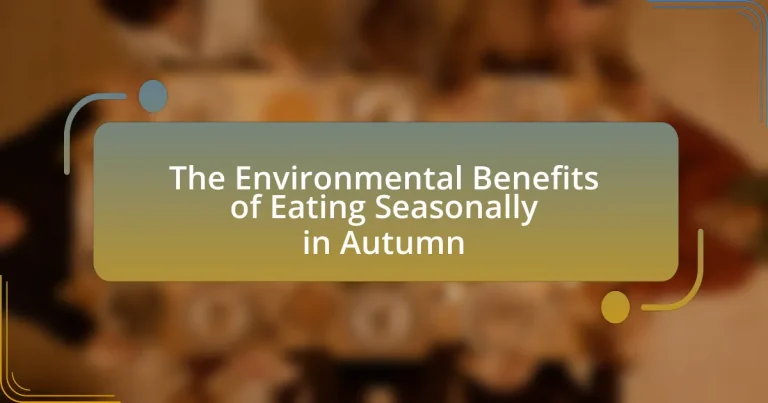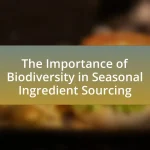The article focuses on the environmental benefits of eating seasonally in autumn, highlighting how this practice reduces carbon emissions associated with food transportation and promotes biodiversity. By choosing locally grown autumn produce, such as apples and squash, consumers can significantly lower their carbon footprints and support sustainable agricultural practices. The article discusses the importance of local sourcing, the types of produce available in autumn, and the long-term impacts of seasonal eating on ecosystems. Additionally, it addresses common challenges faced by consumers in adopting a seasonal eating approach and provides resources to assist with meal planning and accessing seasonal foods.

What are the Environmental Benefits of Eating Seasonally in Autumn?
Eating seasonally in autumn provides significant environmental benefits, primarily by reducing carbon emissions associated with food transportation. When consumers choose locally grown autumn produce, such as apples and squash, they minimize the distance food travels from farm to table, which decreases fossil fuel consumption and greenhouse gas emissions. According to a study by the Food and Agriculture Organization, local food systems can reduce carbon footprints by up to 30% compared to imported foods. Additionally, seasonal eating supports biodiversity by encouraging the cultivation of a variety of crops, which can enhance soil health and reduce the need for chemical fertilizers and pesticides. This practice also promotes sustainable agricultural practices, as local farmers are more likely to engage in environmentally friendly methods to meet community demand.
How does eating seasonally impact the environment?
Eating seasonally positively impacts the environment by reducing carbon emissions associated with food transportation and promoting biodiversity. When consumers choose locally grown, seasonal produce, they minimize the need for long-distance shipping, which significantly lowers greenhouse gas emissions. For instance, a study by the Food and Agriculture Organization (FAO) indicates that food transport contributes approximately 11% of total greenhouse gas emissions in the food supply chain. Additionally, seasonal eating supports local farmers and encourages the cultivation of diverse crops, which enhances soil health and ecosystem resilience. This practice helps maintain agricultural biodiversity, as diverse crops can better withstand pests and diseases, reducing the need for chemical pesticides.
What are the key environmental advantages of seasonal eating?
Seasonal eating significantly reduces the carbon footprint associated with food transportation. By consuming locally grown produce that is in season, the need for long-distance shipping is minimized, which decreases greenhouse gas emissions. For example, food transported over long distances can generate up to 11 times more carbon emissions compared to locally sourced food. Additionally, seasonal eating supports biodiversity by encouraging the cultivation of a variety of crops, which helps maintain healthy ecosystems. This practice also promotes sustainable farming methods, as local farmers are more likely to use environmentally friendly practices that preserve soil health and reduce chemical inputs.
How does seasonal eating reduce carbon footprints?
Seasonal eating reduces carbon footprints by minimizing the transportation emissions associated with food distribution. When consumers choose locally grown, in-season produce, they decrease the distance food travels from farm to table, which significantly lowers greenhouse gas emissions. For example, food that is grown and consumed locally can reduce carbon emissions by up to 50% compared to food that is shipped from distant locations. Additionally, seasonal foods often require less energy for storage and preservation, further contributing to lower overall carbon footprints.
Why is autumn a significant season for seasonal eating?
Autumn is significant for seasonal eating because it marks the harvest of a variety of fruits and vegetables that are at their peak freshness and nutritional value. During this season, crops such as apples, pumpkins, and root vegetables are abundant, providing essential nutrients and flavors that are unique to this time of year. Eating these seasonal foods supports local agriculture, reduces carbon footprints associated with transportation, and promotes biodiversity by encouraging the consumption of a diverse range of crops. Studies indicate that seasonal eating can lead to a decrease in greenhouse gas emissions, as locally sourced foods require less energy for transport and storage.
What types of produce are in season during autumn?
Autumn produce includes apples, pumpkins, squash, sweet potatoes, and Brussels sprouts. These fruits and vegetables thrive in cooler temperatures and are typically harvested from late summer through fall. For example, apples are harvested from September to November, while pumpkins are ready for harvest in October. Eating these seasonal foods supports local agriculture and reduces the carbon footprint associated with transporting out-of-season produce.
How does autumn produce contribute to biodiversity?
Autumn produce contributes to biodiversity by supporting a variety of plant and animal species through the availability of diverse food sources. Seasonal fruits and vegetables, such as pumpkins, apples, and root vegetables, provide essential nutrients for wildlife, including insects, birds, and mammals, which rely on these resources for sustenance during the colder months. Additionally, the cultivation of diverse crops in autumn promotes genetic diversity within agricultural systems, enhancing resilience against pests and diseases. Studies have shown that diverse cropping systems can lead to increased ecosystem stability and productivity, further underscoring the role of autumn produce in fostering biodiversity.
What role does local sourcing play in autumn seasonal eating?
Local sourcing plays a crucial role in autumn seasonal eating by ensuring that fresh produce is harvested at its peak, which enhances flavor and nutritional value. When consumers choose locally sourced foods, they reduce the carbon footprint associated with transportation, as these items typically travel shorter distances from farm to table. For instance, a study by the USDA found that local food systems can reduce greenhouse gas emissions by up to 25% compared to conventional food distribution methods. Additionally, local sourcing supports regional economies and promotes biodiversity by encouraging the cultivation of a variety of seasonal crops. This practice not only benefits individual health through fresher options but also contributes to sustainable agricultural practices that are vital during the autumn season.
How does buying local reduce transportation emissions?
Buying local reduces transportation emissions by minimizing the distance food travels from producer to consumer. When consumers purchase locally sourced products, the need for long-distance transportation, which often relies on fossil fuels, is significantly decreased. For instance, food that is grown within a 100-mile radius typically requires 10 times less energy for transportation compared to food that is shipped from thousands of miles away. This reduction in transportation distance directly correlates with lower greenhouse gas emissions, contributing to a smaller carbon footprint associated with food consumption.
What are the benefits of supporting local farmers in autumn?
Supporting local farmers in autumn enhances food sustainability and reduces environmental impact. By purchasing seasonal produce, consumers decrease the carbon footprint associated with long-distance transportation, as local food typically travels shorter distances from farm to table. Additionally, supporting local agriculture fosters biodiversity, as local farmers often grow a variety of crops suited to the region, promoting healthier ecosystems. Research indicates that local farms utilize fewer synthetic fertilizers and pesticides, leading to improved soil health and reduced chemical runoff into waterways. Thus, supporting local farmers in autumn not only benefits the economy but also contributes positively to environmental conservation.
How can individuals maximize the environmental benefits of eating seasonally in autumn?
Individuals can maximize the environmental benefits of eating seasonally in autumn by choosing locally sourced produce that is in peak harvest during this season. Consuming fruits and vegetables that are grown nearby reduces transportation emissions, as food does not need to be shipped long distances. For example, apples, pumpkins, and root vegetables are typically abundant in autumn and have a lower carbon footprint when sourced from local farms. Additionally, supporting local farmers through farmers’ markets or community-supported agriculture (CSA) programs fosters sustainable agricultural practices and helps maintain biodiversity. Research indicates that local food systems can reduce greenhouse gas emissions by up to 50% compared to conventional food supply chains. By prioritizing seasonal and local options, individuals contribute to a more sustainable food system and reduce their overall environmental impact.
What practical tips can help consumers choose seasonal foods?
To choose seasonal foods effectively, consumers should prioritize local farmers’ markets, as these venues typically offer produce that is in season and freshly harvested. Seasonal foods are often more flavorful and nutrient-dense because they are picked at their peak ripeness. Additionally, consumers can consult seasonal produce guides, which provide information on what fruits and vegetables are in season during specific months. Research indicates that eating seasonally can reduce carbon footprints by minimizing transportation emissions associated with out-of-season produce. By selecting seasonal foods, consumers not only enjoy better taste and nutrition but also contribute to environmental sustainability.
How can meal planning enhance the benefits of seasonal eating?
Meal planning enhances the benefits of seasonal eating by optimizing the use of fresh, local ingredients, which reduces food waste and supports sustainable agriculture. By planning meals around seasonal produce, individuals can ensure they are consuming fruits and vegetables at their peak freshness, which not only improves nutritional value but also minimizes the carbon footprint associated with transportation. Research indicates that seasonal eating can lead to a 25% reduction in greenhouse gas emissions compared to out-of-season food consumption, as local sourcing typically requires less energy for transport. Thus, effective meal planning aligns dietary choices with environmental sustainability, reinforcing the positive impact of seasonal eating.
What are the long-term impacts of seasonal eating on the environment?
Seasonal eating has significant long-term positive impacts on the environment, primarily by reducing carbon emissions associated with food transportation and promoting biodiversity. When consumers choose locally sourced, seasonal foods, they decrease the need for long-distance shipping, which is responsible for approximately 11% of global greenhouse gas emissions from food transport. Additionally, seasonal eating supports local agriculture, which often employs sustainable farming practices that enhance soil health and reduce chemical inputs, contributing to ecosystem resilience. Studies indicate that local farms practicing seasonal growing can improve biodiversity by rotating crops and maintaining diverse plant species, which is essential for healthy ecosystems.
How does seasonal eating contribute to sustainable agriculture practices?
Seasonal eating contributes to sustainable agriculture practices by promoting the consumption of locally grown foods that align with natural growing cycles. This practice reduces the carbon footprint associated with transportation, as seasonal foods are often harvested and consumed within the same region, minimizing the need for long-distance shipping. Additionally, seasonal eating supports local farmers, encouraging them to adopt environmentally friendly farming methods that enhance soil health and biodiversity. Research indicates that local food systems can reduce greenhouse gas emissions by up to 25% compared to conventional food systems reliant on imports. By prioritizing seasonal produce, consumers help create a demand for sustainable agricultural practices that protect ecosystems and promote food security.
What future trends are emerging in seasonal eating and environmental sustainability?
Future trends in seasonal eating and environmental sustainability include an increased focus on local sourcing, plant-based diets, and technology-driven food systems. Local sourcing reduces carbon footprints by minimizing transportation, while plant-based diets are gaining popularity due to their lower environmental impact compared to meat consumption. Additionally, innovations such as vertical farming and precision agriculture are emerging, enhancing food production efficiency and sustainability. According to a report by the Food and Agriculture Organization, local food systems can reduce greenhouse gas emissions by up to 30%, supporting the shift towards more sustainable eating practices.
What are some common challenges in adopting a seasonal eating approach in autumn?
Common challenges in adopting a seasonal eating approach in autumn include limited availability of certain fresh produce, difficulty in meal planning, and potential higher costs for seasonal items. Limited availability arises because some fruits and vegetables are not in season, making it hard to find a diverse range of options. Difficulty in meal planning occurs as individuals may struggle to create recipes that utilize seasonal ingredients effectively. Additionally, higher costs can be associated with purchasing organic or locally sourced seasonal produce, which may not be as readily available in all markets. These challenges can hinder the transition to a seasonal eating lifestyle during autumn.
How can consumers overcome barriers to eating seasonally?
Consumers can overcome barriers to eating seasonally by planning meals around seasonal produce, utilizing local farmers’ markets, and educating themselves about the benefits of seasonal eating. Meal planning allows consumers to incorporate seasonal fruits and vegetables into their diets, reducing reliance on out-of-season imports. Local farmers’ markets often provide fresh, seasonal options at competitive prices, making it easier for consumers to access these foods. Additionally, understanding that seasonal eating can lead to better taste, nutritional value, and environmental sustainability reinforces the advantages of this practice, as seasonal produce is typically harvested at its peak ripeness and requires less energy for transportation.
What resources are available to assist with seasonal eating in autumn?
Resources available to assist with seasonal eating in autumn include local farmers’ markets, seasonal produce guides, and online platforms that provide recipes and meal planning tools. Local farmers’ markets offer fresh, locally grown fruits and vegetables that are in season, such as pumpkins, apples, and squash, promoting sustainable agriculture. Seasonal produce guides, like those from the USDA, detail which fruits and vegetables are at their peak during autumn, helping consumers make informed choices. Online platforms, such as seasonal recipe websites, provide meal ideas that utilize autumn produce, encouraging the use of ingredients that are both fresh and environmentally friendly.


